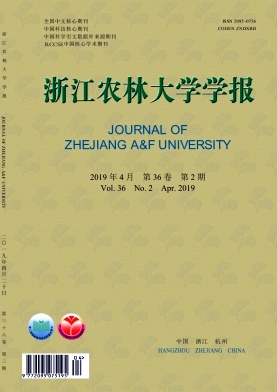-
富营养化是中国最主要的水污染问题,其主要限制因子是磷的质量浓度[1]。根据Liebig最低营养学限制定律,磷质量浓度控制藻类生长丰度,当水中磷高于0.5 mg·L-1时,富营养化程度将加剧[2]。目前广泛应用的除磷技术有化学沉淀法[3-4]、生物法[5-6]和吸附法[7]。化学沉淀法除磷操作简便,见效快,但运行费用较高,且污泥产量大,易造成二次污染[8];生物法运行费用较低,但对运行条件及环境要求相对较高,稳定性较差,且单纯依靠生物处理难以达标排放[9-10];吸附法因具有工艺简单、操作简便、除磷效果显著,且吸附剂可循环使用等优点而受到广泛关注[7, 11]。底泥是水体的沉积物,污染物进入水体后,经吸附、络合、沉淀等作用最终会在其中沉积,受到水体温度、pH值和电位改变或水体扰动则重新释放污染上覆水体[12-13]。因而,底泥是水体的重要内源污染,城市建设中多采用定期疏浚以控制底泥污染。底泥的矿物组成与黏土类似,可在高温下发泡膨胀,替代黏土作为陶粒制备的原料[14]。陶粒是一种表面粗糙的多孔物质,微生物附着性好,具有一定的吸附能力,近年来,作为生物滤料和基质在水处理中得到了广泛的应用[15-16]。目前采用疏浚底泥制备高效除磷型陶粒的研究鲜见报道,本研究以疏浚底泥为主要原料,辅以造孔剂和水泥,通过单因素实验、正交试验确定高效除磷型底泥陶粒的最佳制备条件,分析底泥陶粒的性能、经济性及实际运用可行性,为废水深度除磷、控制水体排污口磷排放及水体富营养化提供基础数据,亦为疏浚底泥的资源化利用提供参考。
HTML
-
底泥取自浙江省温州市龙湾区某河道,黑色,具臭味,经自然干燥、105 ℃烘干、粉碎后过100目筛;X射线荧光光谱(XRF)成分分析表明,河道底泥中的主要成分(质量百分比):二氧化硅(SiO2) 62.00%,三氧化二铝(Al2O3)19.26%,三氧化二铁(Fe2O3)7.53%,氧化钙(CaO)1.41%,氧化锰(MgO)2.91%,氧化钠(Na2O)1.10 %,氧化钾(K2O)3.02%,灼减率10.9%。旱伞草Cyperus alternifolius残体取自温州市龙湾区某河道,自来水洗净后,切成1~2 cm小段,105 ℃烘干,粉碎后过100目筛。无烟煤产自山西,烘干,粉碎后过100目筛。水泥为市售。
-
称取河道底泥30.0 g,加入造孔剂旱伞草和煤粒(2.0~6.0 g),水泥(4.0~6.0 g),加水混合,制成直径3~5 mm圆球,105 ℃下干燥3 h;放入马弗炉中,350 ℃预热30 min,后以3 ℃·min-1速率升温至焙烧温度(1 060~1 100 ℃),烧制15~45 min后自然冷却至室温,制得陶粒。
-
根据国家标准CJ/T 299-2008《水处理用人工陶粒滤料》测定陶粒的含泥量、盐酸可溶率、破碎率与磨损率、空隙率、表观密度、堆积密度等指标[17]。重复测定2次·样品-1,2次试验结果之差不大于平均值的2.0%,取平均值作为测定值。
-
取3.0 g陶粒于锥形瓶中,加入50.0 mL质量浓度为10.0 mg·L-1磷酸二氢钾溶液,25 ℃,120 r·min-1恒温振荡24 h,过滤,采用《水和废水监测分析方法》(第四版)钼锑抗分光光度法(λ=700 nm)测定滤液中总磷质量浓度[18]。重复3次,3个平行样测定值相对误差不大于5.0%,取平均值。
-
取吸附饱和陶粒3.0 g于250.0 mL锥形瓶中,加入100.0 mL 2.0 mol·L-1氢氧化钠(NaOH)溶液,25 ℃,120 r·min-1恒温振荡24 h,过滤,测定滤液中总磷质量浓度。以100.0 mL蒸馏水作空白对比。
1.1. 材料
1.2. 陶粒的制备
1.3. 陶粒性能分析
1.4. 陶粒除磷能力
1.5. 陶粒再生
-
底泥中有机质含量较低(灼减率10.9%)会影响陶粒的发泡效果[19],造成空隙率较低,因而需要添加适宜的造孔剂提高其发泡效果。目前常用的造孔剂有木屑、泡沫、秸秆、煤、碳酸氢铵以及碳酸钙等。分别以这几种物质为造孔剂(添加量均为2.0 g),对比造孔效果表明(表 1):旱伞草和煤的造孔效果较为理想,且二者存在互补作用。因此,后续实验采用m(煤):m(旱伞草)=1:1混合作为造孔剂。
造孔剂 造孔效果 木屑 陶粒中仍存在部分木屑 泡沫 泡沫可在低温融化,但陶粒表面光滑,孔隙并不连通。 旱伞草 表面粗糙 碳酸氢铵 发泡效果不好 碳酸钙 发泡效果不好,加入量多时,表面有结圈现象 煤 陶粒有许多大小不一的小孔,但表面粗糙度不够 Table 1. Pore-forming performance of different pore-forming agents
陶粒的除磷效果、吸水率、空隙率、破碎率与磨损率、含泥量及盐酸可溶率均随造孔剂量增加而增大(表 2)。当造孔剂量从2.0 g增至6.0 g时,除磷率由64.58%升至81.48%,吸水率由25.18%升至34.15%,空隙率从53.87%升至58.85%,破碎率与磨损率从1.49%升至1.87%,含泥量和盐酸可溶率分别由0.49%,0.84%升到0.65%和1.22%。陶粒密度的变化则相反,造孔剂量从2.0 g增至6.0 g,表观密度和堆积密度分别下降16.30%和25.30%。分析认为,陶粒烧制过程中,造孔剂中有机质分解产生膨胀气体,陶粒的开孔率提高,导致空隙率和吸水率增大,表观密度降低。而气孔的存在减少了陶粒承受负荷的有效截面积,应力集中而强度降低,引起破碎率增大[19-20]。陶粒内部丰富的孔隙,使得溶液中磷的渗透性加大,磷与陶粒中有效组分的接触概率上升,是除磷效果提高的原因。造孔剂煤的金属矿物成分,消耗了一部分盐酸,陶粒内部丰富的孔隙,更易受盐酸腐蚀破坏,可能是盐酸可溶率及含泥量增加的原因。实验同时发现,当造孔剂添加量超过6.0 g时,搓制陶粒较难成型。
m水泥/g 除磷率/% 空隙率/% 吸水率/% 盐酸可溶率/% 破碎率与磨损率/% 含泥量/% 表观密度/(kg·m-3) 堆积密度/(kg·m-3) 2.0 64.58 53.87 25.18 0.84 1.49 0.49 1 577 723 4.0 64.92 56.80 27.55 1.10 1.63 0.62 1 437 623 6.0 81.48 58.85 34.15 1.22 1.87 0.65 1 320 540 Table 2. Effect of pore-forming agent on characteristics of ceramsite
-
从表 3可见:当水泥量由4.0 g增至6.0 g时,陶粒的空隙率略有升高(由55.60%升至57.79%),除磷率显著上升(由58.93%升到79.60%);推测原因是水泥中含有氧化钙,磷酸根离子与钙反应形成磷酸钙沉淀,而随着水泥量增大而增大的空隙率,增大了钙与溶液中磷酸根离子的接触概率。陶粒的破碎率与磨损率及含泥量也有所上升。二氧化硅(SiO2)和三氧化二铝(Al2O3)是陶粒产生强度和形成结构的主要物质基础[21],两者在水泥中的质量占比不足底泥中的1/3,因而水泥量增加导致二氧化硅和三氧化二铝减少。多次预实验发现,水泥量过高时,陶粒的强度下降明显,烧结后陶粒表面形成一层薄的覆盖层,震荡时,少量粉末脱落,不但影响出水浊度,也增加了破损率与磨损率及含泥量;陶粒烧结过程中产生的液相量及液相黏度影响陶粒的膨胀和孔隙的形成。如果液相量不足或黏度较小,则烧结过程中产生的气体容易外溢,无法形成丰富的孔隙,也就无法膨胀;若液相量过大或黏度较强,则会使气体的膨胀力被液相过分地抑制,也不能形成发达孔隙[22]。钙盐是助熔剂,可以降低液相生成的温度,对生成的液相起稀释作用。因而,适量钙盐利于陶粒孔隙的形成,增大陶粒吸水率,降低表观密度和堆积密度。随着水泥量增大,水泥中氧化钙遇到强酸溶出,引起陶粒的盐酸可溶率上升。
m水泥/g 除磷率/% 空隙率/% 吸水率/% 盐酸可溶率/% 破碎率与磨损率/% 含泥量/% 表观密度/(kg·m-3) 堆积密度/(kg·m-3) 4.0 58.93 55.60 27.83 0.79 1.53 0.52 1 473 650 5.0 72.46 56.45 30.37 1.14 1.71 0.62 1 447 633 6.0 79.60 57.79 33.68 1.23 1.75 0.62 1 413 603 Table 3. Effect of cement on characteristics of ceramsite
-
烧结温度由1 060 ℃上升到1 100 ℃时,陶粒的堆积密度和表观密度增大,空隙率、吸水率下降(表 4)。研究表明:烧结温度越高,熔融产生的液相量越大,固体颗粒由于液相表面张力的作用相互接近;其次,因表面黏度下降,液相更容易填充到气孔中使坯体致密化,导致空隙率、吸水率、破碎率与磨损率及含泥量下降[23-24]。烧结温度对除磷率的影响较大。从表 4可见:当烧结温度从1 060 ℃升至1 100 ℃时,空隙率由58.80%降至54.58%,除磷率降至51.23%。分析认为,随烧结温度升高,陶粒空隙率下降,陶粒中金属盐固化率增大[25-26],导致与磷酸盐结合的金属离子减少,造成除磷率下降;同时坯料中的物相发生变化,酸可溶组分烧结变为难溶组分,使酸溶出率降低,陶粒的盐酸可溶率明显减小。
T烧结/℃ 除磷率/% 空隙率/% 吸水率/% 盐酸可溶率/% 破碎率与磨损率/% 含泥量/% 表观密度/(kg·m-3) 堆积密度/(kg·m-3) 1060 88.37 58.80 34.85 1.48 2.03 0.70 1 353 560 1080 71.31 56.43 28.92 1.10 1.69 0.64 1 450 630 1100 51.23 54.58 23.12 0.59 1.25 0.39 1 530 697 Table 4. Effect of sintering temperature on characteristics of ceramsite
-
延长保温时间不利于陶粒除磷。从表 5可见:当保温时间从15 min延长至45 min时,空隙率从56.61%降至55.71%,盐酸可溶率由1.21%降至0.83%,除磷率从75.76%降至63.77%。推测原因是保温时间越长,熔融产生的液相量越大,金属的固化率越多,导致陶粒的空隙率下降,与磷酸盐结合的金属离子减少。同时发现陶粒的破碎率与磨损率、含泥量、吸水率均下降,而堆积密度和表观密度在保温的前30 min变化幅度较小,此后呈增大趋势。推测原因是长时间保温,熔融产生的液相有足够的时间填充气孔,使陶粒内部结构更致密。
t保温/min 除磷率/% 空隙率/% 吸水率/% 盐酸可溶率/% 破碎率与磨损率/% 含泥量/% 表观密度/(kg·m-3) 堆积密度/(kg·m-3) 15 75.76 56.61 33.88 1.21 1.82 0.62 1 430 623 30 71.31 55.82 29.15 1.12 1.71 0.59 1 440 610 45 63.77 55.71 28.85 0.83 1.45 0.54 1 463 653 Table 5. Effect of holding time on characteristics of ceramsite
-
根据单因素实验,选择造孔剂(A)、水泥(B)、烧结温度(C)和保温时间(D)4个因素,各因素取3个水平:A(2.0,4.0,6.0 g),B(4.0,5.0,6.0 g),C(1 060,1 080,1 100 ℃),D(15,30,45 min),进行正交试验。从表 6可见:A2B3C1D2,A3B2C1D3和A3B3C2D1等3组除磷率分别为93.23%,95.25%和95.55%,且各组其他性能指标均能满足CJ/T299-2008的要求。
试验号 试验组合 吸水率/% 堆积密度/ (kg·m-3) 表观密度/ (kg·m-3) 空隙率/% 盐酸可溶率/% 除磷率/% 破碎率与磨损率/% 含泥量/% 1 A1B1C1D1 33.20 670 1 500 55.33 1.15 76.67 1.90 0.61 2 A1B2C2D2 23.40 710 1 580 55.06 1.03 67.07 1.61 0.58 3 A1B3C3D3 18.95 790 1 650 52.12 0.33 50.00 0.95 0.29 4 A2B1C2D3 24.60 670 1 490 55.03 0.66 46.50 1.32 0.56 5 A2B2C3D1 24.70 690 1 510 54.30 0.88 55.05 1.43 0.49 6 A2B3C1D2 33.35 510 1 310 61.07 1.76 93.23 2.15 0.80 7 A3B1C3D2 25.70 610 1 430 57.34 0.56 53.64 1.38 0.40 8 A3B2C1D3 38.00 500 1 250 60.00 1.51 95.25 2.09 0.78 9 A3B3C2D1 38.75 510 1 280 60.20 1.60 95.55 2.14 0.77 Table 6. Performance indexes values of orthogonal test
对正交试验结果做极差分析发现(表 7):烧结温度对除磷率、盐酸可溶率、破碎率与磨损率、吸水率和含泥量的影响最大,极差值(R)分别为37.14%,0.89%,0.78%,11.73%和0.31%。造孔剂对空隙率、表观密度及堆积密度的影响最大,极差值分别为4.98%,257 kg·m-3和183 kg·m-3。4个因素对除磷率的影响从大到小依次为烧结温度、水泥、造孔剂、保温时间。
因素 吸水率/% 盐酸可溶率/% 表观密度/(kg·m-3) 堆积密度/(kg·m-3) 空隙率/% 含泥量/% 破碎率与磨损率/% 除磷率/% k1 k2 k3 R k1 k2 k3 R k1 k2 k3 R k1 k2 k3 R k1 k2 k3 R k1 k2 k3 R k1 k2 k3 R k1 k2 k3 R A 25.18 27.55 34.15 8.97 0.84 1.10 1.22 0.38 1 577 1 437 1 320 257 723 623 540 183 53.87 56.80 58.85 4.98 0.49 0.62 0.65 0.16 1.49 1.63 1.87 0.38 64.58 64.92 81.48 16.69 B 27.83 30.37 33.68 5.85 0.79 1.14 1.23 0.44 1 473 1 447 1 413 60 650 633 603 47 55.60 56.45 57.79 2.19 0.52 0.62 0.62 0.10 1.53 1.71 1.75 0.22 58.93 72.46 79.60 20.67 C 34.85 28.92 23.12 11.73 1.48 1.10 0.59 0.89 1 353 1 450 1 530 177 560 630 697 137 58.80 56.43 54.58 4.22 0.70 0.64 0.39 0.31 2.03 1.69 1.25 0.78 88.37 71.31 51.23 37.14 D 33.88 29.15 28.85 5.03 1.21 1.12 0.83 0.38 1 430 1 440 1 463 33 623 610 653 30 56.61 55.82 55.71 0.90 0.62 0.59 0.54 0.08 1.82 1.71 1.45 0.37 75.76 71.31 63.77 11.99 说明:ki表示任意列上水平号为i时所对应的试验结果之和的平均值 Table 7. Performance indexes values of orthogonal test
-
磷酸盐为阴离子,可利用氢氧化钠溶液再生。实验结果表明:用2.0 mol·L-1氢氧化钠溶液对吸附饱和陶粒中磷进行解吸,24 h后解吸率达88.58%。而空白对照中几乎不发生解吸。
-
高效除磷型底泥陶粒以疏浚底泥和水生植物残体为主要原料(占陶粒总质量70.0%以上),节省了黏土的费用(约50元·m-3),降低了陶粒烧制成本。采用河道底泥和水生植物残体制备水处理陶粒,属废弃物资源化利用领域,可获得一定的政府补贴,且当污泥质量分数 > 30%时,陶粒产品可享受5 a内免交产品增值税和企业所得税的税收优惠。因此,高效除磷型底泥陶粒制备经济可行。底泥陶粒可应用于曝气生物滤池强化废水除磷,也可作为人工湿地或生态浮岛基质,控制水体富营养化,应用领域较为广泛。
2.1. 造孔剂添加量对陶粒性能的影响
2.2. 水泥添加量对陶粒性能的影响
2.3. 烧结温度对陶粒性能的影响
2.4. 保温时间对陶粒性能的影响
2.5. 正交试验
2.6. 陶粒再生
2.7. 经济性及实际运用可行性分析
-
通过单因素实验和正交试验,得到高效除磷型底泥陶粒制备的最佳条件为造孔剂6.0 g,水泥6.0 g,烧结温度1 060 ℃,保温时间15 min。对陶粒除磷性能的影响从大到小依次为烧结温度、水泥、造孔剂、保温时间。
最佳制备条件下烧制的陶粒空隙率60.20%,吸水率38.75%,破碎率与磨损率2.14%,盐酸可溶率1.60%,底泥质量分数0.77%,表观密度1 280 kg·m-3和堆积密度510 kg·m-3,符合CJ/T299-2008的要求。
初始浓度为10.0 mg·L-1的含磷废水,经高效除磷型底泥陶粒处理后,除磷率达95.55%。吸附饱和陶粒可用2.0 mol·L-1氢氧化钠再生。底泥陶粒可应用于曝气生物滤池强化废水除磷,也可作为人工湿地或生态浮岛基质,在控制水体富营养化上的应用是可行的。





 本站查看
本站查看


 DownLoad:
DownLoad: